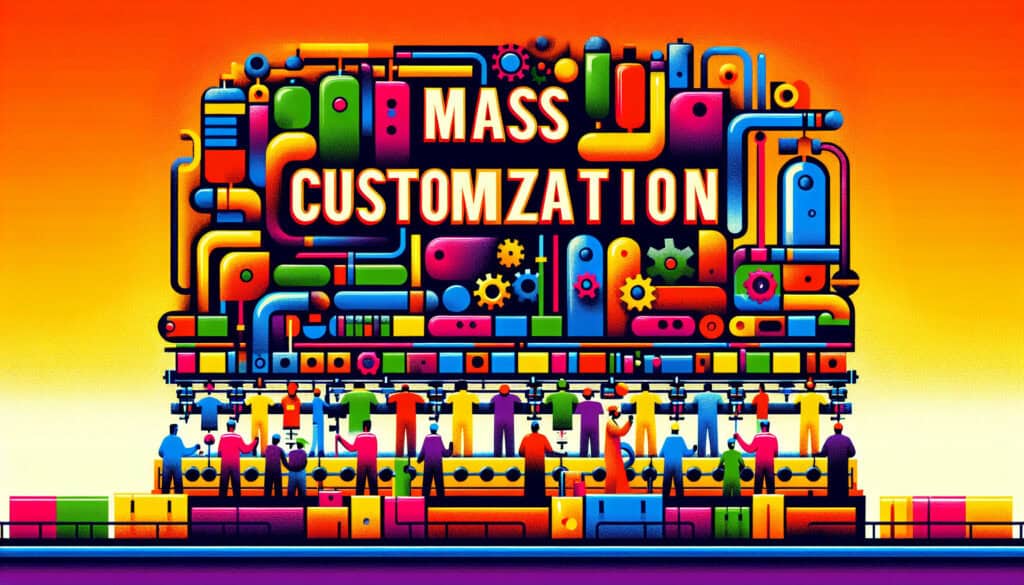To produce customized products on a large scale.
- Methodologies: Lean Sigma, Manufacturing, Problem Solving, Quality
Mass Customization

Mass Customization
- Agile Methodology, Customer Experience, Lean Manufacturing, Manufacturing, Product Design, Product Development
Objective:
How it’s used:
- A manufacturing and marketing strategy that combines the flexibility of custom-made products with the low unit costs of mass production. This is often achieved through modular product design and flexible manufacturing systems.
Pros
- Allows for a high degree of customization at a low cost; Can increase customer satisfaction and market share.
Cons
- Can be complex to manage and may require significant investment in technology; Can lead to longer lead times.
Categories:
- Customers & Marketing, Manufacturing
Best for:
- Producing customized products, such as computers, cars, or shoes, on a large scale.
Mass Customization has found its applications across various industries, including consumer electronics, automotive, and footwear, where companies aim to meet specific customer preferences while maintaining cost efficiency. Within the project phase of product development, this methodology is particularly suited to the design and prototyping stages, where iterative feedback loops can rapidly adapt modular components to meet diverse client needs through advanced manufacturing technologies such as 3D printing and CNC machining. Engaging cross-functional teams from engineering, marketing, and design ensures that all aspects of customization are addressed, allowing for a seamless integration of consumer input into the product development process. Initiatives often stem from market research that identifies customer demands for personalized experiences, leading to strategies that enhance brand loyalty and increase profit margins. For instance, automotive firms like BMW and Tesla utilize this approach to offer consumers the ability to configure their vehicles with various features, colors, and technologies while still benefiting from the efficiencies of mass production techniques. Furthermore, companies implementing Mass Customization invest in flexible manufacturing systems that can accommodate varying production volumes and configurations, further driving down costs while increasing responsiveness to changing market trends. This dynamic strategy not only satisfies individual consumer desires but also encourages a stronger emotional connection between the brand and its clients, ultimately contributing to sustained competitive advantage.
Key steps of this methodology
- Identify customer segments and their specific customization needs.
- Design a modular product architecture that allows for variations without significant changes to production processes.
- Develop a flexible manufacturing system that can adapt to different product configurations efficiently.
- Implement advanced information systems to manage and track customer orders and preferences in real-time.
- Integrate supply chain partners to ensure timely availability of customizable components.
- Establish a pricing strategy that reflects the cost of customization while remaining competitive.
- Launch marketing campaigns that highlight the customization options and the value proposition to target segments.
- Gather post-purchase feedback to continuously refine the customization options and improve the product offering.
Pro Tips
- Incorporate advanced data analytics to monitor customer preferences and adapt offerings in real-time, enhancing responsiveness to market trends.
- Implement a robust supply chain management system that supports dynamic inventory management to facilitate a seamless flow of customized components.
- Utilize generative design algorithms during the product development phase to explore a wider range of modular configurations efficiently tailored to customer needs.
To read and compare several methodologies, we recommend the
> Extensive Methodologies Repository <
together with the 400+ other methodologies.
Your comments on this methodology or additional info are welcome on the comment section below ↓ , so as any engineering-related ideas or links.
Related Posts
Musculoskeletal Discomfort Questionnaires
Multivariate Testing (MVT)
Multiple Regression Analysis
Motion Capture Systems
MoSCoW Method
Mood’s Median Test